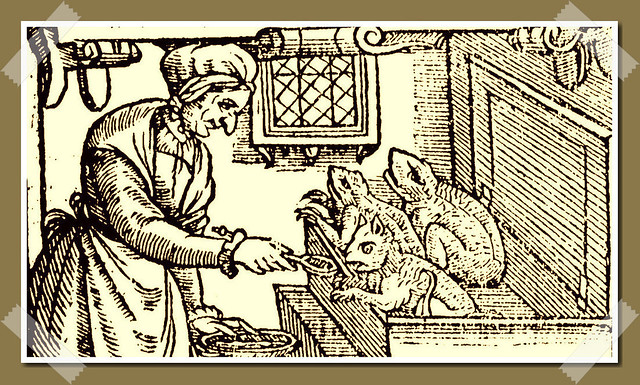An imp is a small Demon usually kept inside a bottle or ring. An imp is like a Familiar and is comparable to the Djinn. It is evoked for magical purposes. Imps are both good and evil.
As familiars, imps can take the shape of animals, including insects and birds, which are sent out on tasks at the command of a witch or magician. Witch hunters during the Inquisition accused witches of rewarding their imps for evil deeds by suckling them with their own Blood, which the imps sucked from fingers, warts, breasts, or any protuberance on the skin. In England the Lincoln Imp is a carved stone Demon on a column in the Angel Choir at the cathedral in Lincoln, constructed in the 12th century and once the tallest structure in the world. The grinning imp is in a seated position with one leg crossed over the other. There are different versions of the legend. One version tells in rhyme that one day the Devil was in good spirits and let his young Demons out to play. One rode on the wind to Lindum (Lincoln) and ordered the wind to take him into the church, intending to wreak havoc there. The imp started breaking things in the Angel Choir and was turned to stone by angels in punishment.
Another version says that in the 14th century, the Devil sent two imps out to make mischief. First, they went to Chesterfield and twisted the spire of the church there, and then they went to Lincoln Cathedral. They tripped the bishop and smashed tables and chairs and started to destroy the Angel Choir. An angel ordered them to stop. One of the imps defiantly flew up to a stone pillar and began to throw heavy objects at the angel. The angel turned him into stone, leaving him there forever. The second imp hid in the wreckage and made his escape by latching on to the broomstick of a passing witch. The witch turned him into a black cat to become her familiar. The Lincoln Imp is associated with both good and bad luck. The imp has been used in jewelry and even worn by royalty. In 1928, the prince of Wales (the future King Edward VII) was given an imp tie pin. The next year, two of his horses won major races, the Grand National and the Epsom Derby.
FURTHER READING:
- Kesson, H. J. The Legend of the Lincoln Imp. Lincoln, England: J. W. Ruddock & Sons, 1904.
SOURCE:
The Encyclopedia of Demons and Demonology – Written by Rosemary Ellen Guiley – Copyright © 2009 by Visionary Living, Inc.

An imp is a small Demon, often kept inside a bottle or ring and used for magical purposes. Imps are evoked and commanded to carry out tasks and spells.
Witches were said to keep imps that assumed different forms, such as toads, rodents and especially flies, spiders and other insects. When accused witches were imprisoned, they were watched closely for any appearances of their imps. Prisons were full of insects and rodents, so it was rare that a cell would not have such visitors. Guards would pounce on them, and if they were killed, it meant they were harmless animals or bugs. But if a fly or spider escaped, it was taken as a sure sign of the witch’s imp.
Witches were accused of using imps to carry out evil deeds upon innocent people, such as bewitchment, ill fortune, accidents and even death. In return, the witches suckled the imps with their own blood, using their fingers or protuberances on the body. Witch hunters searched bodies for Witch’s Marks, usually warts, discoloured skin, and unnatural lumps believed to serve as teats or paps.
In some witch trials, the term “imp” was used interchangeably with Familiar.
FURTHER READING:
- Upham, Charles. History of Witchcraft and Salem Village. Boston: Wiggin and Lunt, 1867.
SOURCE:
The Encyclopedia of Witches, Witchcraft and Wicca – written by Rosemary Ellen Guiley – Copyright © 1989, 1999, 2008 by Visionary Living, Inc.